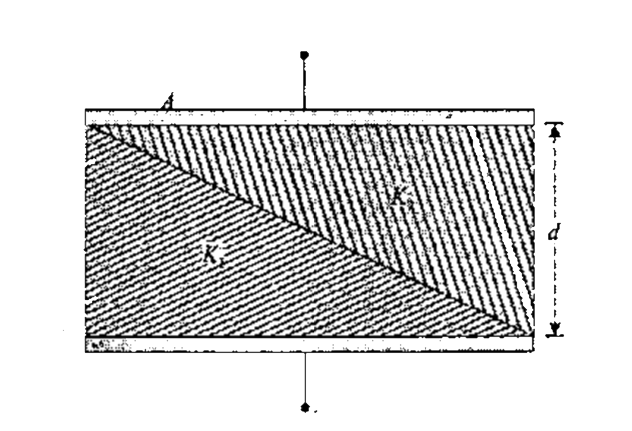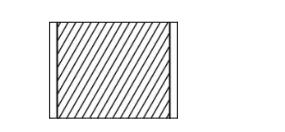In a liquid medium of dielectric constant K and of specific gravity 2, two identically charged spheres are suspended from a fixed point by threads of equal lengths. The angle between them is 90∘. In another medium of unknown dielectric constant K1, and specific gravity 4, the angle between them becomes 120∘. If density of material of spheres is 8gm/cc then find K1.
To solve the problem, we need to analyze the forces acting on the charged spheres in both mediums and apply the principles of electrostatics and buoyancy.
1. Understanding the Forces in Medium 1:
- In the first medium, the two charged spheres create an electrostatic force that causes them to repel each other. The angle between the threads is 90 degrees.
- The electrostatic force Fe between the two spheres is given by:
Fe=14πϵ0Kq2r2
where r is the distance between the centers of the spheres.
2. Calculating the Distance between the Spheres:
- Since the angle between the threads is 90 degrees, the distance r can be expressed in terms of the length l of the threads:
r=l√2
3. Weight of the Spheres in Medium 1:
- The weight W of each sphere is given by:
W=Volume×Density×g=43πr3s⋅8⋅g
where rs is the radius of the sphere and g is the acceleration due to gravity.
4. Buoyant Force in Medium 1:
- The buoyant force Fb acting on each sphere is:
Fb=Volume of sphere×Density of liquid×g=43πr3s⋅2⋅g
5. Net Force Equation in Medium 1:
- The net force in the vertical direction for each sphere is:
Fe=W−Fb
- Substituting the expressions for W and Fb:
14πϵ0Kq2(l√2)2=43πr3s⋅8g−43πr3s⋅2g
- Simplifying gives:
14πϵ0Kq22l2=43πr3s⋅6g
6. Understanding the Forces in Medium 2:
- In the second medium, the angle between the threads is 120 degrees. The distance r is now:
r=l√3
- The electrostatic force Fe in this medium is:
Fe=14πϵ0K′q2(l√3)2
7. Weight and Buoyant Force in Medium 2:
- The weight remains the same, but the buoyant force changes due to the specific gravity of 4:
Fb=43πr3s⋅4g
8. Net Force Equation in Medium 2:
- The net force in the vertical direction for each sphere is:
Fe=W−Fb
- Substituting gives:
14πϵ0K′q23l2=43πr3s⋅8g−43πr3s⋅4g
- Simplifying gives:
14πϵ0K′q23l2=43πr3s⋅4g
9. Setting Up the Ratio of Forces:
- Now we can set up the ratio of the two equations:
14πϵ0K14πϵ0K′=6g4g⋅3l22l2
- This simplifies to:
K′K=98
10. Finding K′:
- Rearranging gives:
K′=98K
Final Answer:
The dielectric constant K′ in the second medium is 98K.
- In the first medium, the two charged spheres create an electrostatic force that causes them to repel each other. The angle between the threads is 90 degrees.
- The electrostatic force Fe between the two spheres is given by:
Fe=14πϵ0Kq2r2
where r is the distance between the centers of the spheres.
- Since the angle between the threads is 90 degrees, the distance r can be expressed in terms of the length l of the threads:
r=l√2
- The weight W of each sphere is given by:
W=Volume×Density×g=43πr3s⋅8⋅g
where rs is the radius of the sphere and g is the acceleration due to gravity.
- The buoyant force Fb acting on each sphere is:
Fb=Volume of sphere×Density of liquid×g=43πr3s⋅2⋅g
- The net force in the vertical direction for each sphere is:
Fe=W−Fb
- Substituting the expressions for W and Fb:
14πϵ0Kq2(l√2)2=43πr3s⋅8g−43πr3s⋅2g
- Simplifying gives:
14πϵ0Kq22l2=43πr3s⋅6g
- In the second medium, the angle between the threads is 120 degrees. The distance r is now:
r=l√3
- The electrostatic force Fe in this medium is:
Fe=14πϵ0K′q2(l√3)2
- The weight remains the same, but the buoyant force changes due to the specific gravity of 4:
Fb=43πr3s⋅4g
- The net force in the vertical direction for each sphere is:
Fe=W−Fb
- Substituting gives:
14πϵ0K′q23l2=43πr3s⋅8g−43πr3s⋅4g
- Simplifying gives:
14πϵ0K′q23l2=43πr3s⋅4g
- Now we can set up the ratio of the two equations:
14πϵ0K14πϵ0K′=6g4g⋅3l22l2
- This simplifies to:
K′K=98
- Rearranging gives:
K′=98K
The dielectric constant K′ in the second medium is 98K.
Topper's Solved these Questions
- ELECTRIC CHARGES AND FIELDSBOOK - AAKASH SERIESCHAPTER - ELECTRIC CHARGES AND FIELDSEXERCISE - Assess Your Self
13 Videos
- ELECTRIC CHARGES AND FIELDSBOOK - AAKASH SERIESCHAPTER - ELECTRIC CHARGES AND FIELDSEXERCISE - Exercise-I
80 Videos
- DUAL NATURE OF RADIATION AND MATTERBOOK - AAKASH SERIESCHAPTER - DUAL NATURE OF RADIATION AND MATTEREXERCISE - PRACTICE EXERCISEX
42 Videos
- ELECTRIC FIELD AND POTENTIALBOOK - AAKASH SERIESCHAPTER - ELECTRIC FIELD AND POTENTIALEXERCISE - PROBLEMS (LEVEL-II)
26 Videos
Similar Questions
Two identical charged spheres are suspended by strings of equal lengths. The strings make an angle of 30∘ with each other. When suspended in a liquid of density 0.8gcm−3, the angle remains the same. If density of the material of the sphere is 1.6gcm−3, the dielectric constant of the liquid is
View SolutionTwo identical charged spheres are suspended by strings of equal lengths. The strings make an angle of 30∘ with each other. When suspended in a liquid of density 0.8gcm−3, the angle remains the same. If density of the material of the sphere is 1.6gcm−3, the dielectric constant of the liquid is
View SolutionTwo identical charged spheres of material density ρ, suspended from the same point by inextensible strings of equal length make an angle θ between the string. When suspended in a liquid of density σ the angle θ remains the same. The dielectric constant K of the liquid is
View SolutionTwo identical pith balls, each carrying charge q, are suspended from a common point by two strings of equal length l. Find the mass of each ball if the angle between the strings is 2θ in equilibrium.
View SolutionAssertion : Two identical balls are charged by q. They are suspended from a common point by two insulating threads l each. In equilibrium, the angle between the tension in the threads is 180∘. (Ignore gravity).
Reason : In equilibrium tension in the spring is
T=14πε0q.ql2
View SolutionTwo charges exert a force of 10 N on each other when separated by a distance 0.2 m in air. When they are placed in another medium of dielectric constant K=4, and separated by distance R. they exert same force. The distance R equats to
View SolutionTwo similar point charges q1andq2 are placed at a distance r apart in the air. The force between them is F1 . A dielectric slab of thickness t(<r) and dielectric constant K is placed between the charges . Then the force between the same charge . Then the fore between the same charges is F2 . The ratio is
View SolutionThe capacitance of a parallel plate capacitor with plate area A and separation d is C. The space between the plates in filled with two wedges of dielectric constants K1 and K2 respectively. Find the capacitance of resulting capacitor.

View SolutionA parallel plate capacitor has plate area of A separated by distance between them. It is completely filled with dielectric medium, its dielectric constant increases linearly as move from one plate to other plate from k1 to k2 . Then the capacitance of system is given by :

View SolutionA parallel plate capacitor has plate area of A separated by distance between them. It is completely filled with dielectric medium, its dielectric constant increases linearly as move from one plate to other plate from k1 to k2 . Then the capacitance of system is given by :

View Solution
